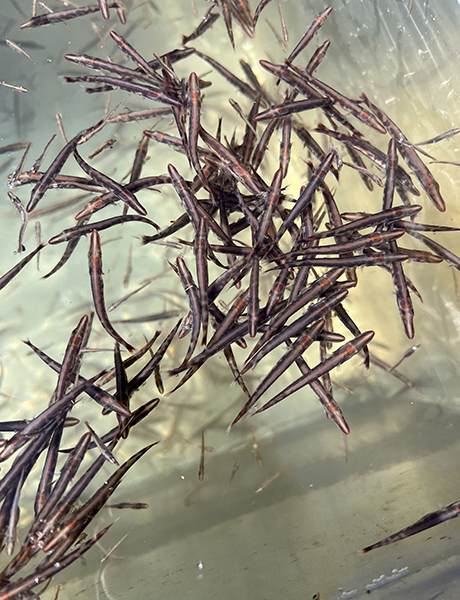
Report Date:
http://www.dfw.state.or.us
BAKER CITY, Ore. – Most people don't get excited when they hear someone has 70,000 extra larval tiger muskie, but then again, most people aren't fish biologists dealing with an overabundance of yellow perch.
The yellow perch population in Phillips Lake (aka Phillips Reservoir) near Baker City has been estimated at 1.5 million, which is far too many. These perch compete for resources and space in the water, resulting in fish that are stunted in size and anglers not being able to catch a decent-sized fish.
The Utah Division of Wildlife Resources has had great success stocking smaller tiger muskie in their reservoirs to control populations of fish and create better fishing opportunities. Tiger muskie are a sterile fish that are a cross between a muskellunge and a northern pike. Besides being known for predating on yellow perch, they are also prized by anglers as a trophy fish to catch.
So when ODFW's La Grande District Fish Biologist, Ethan Brandt, heard that Utah had excess larval tiger muskie available, he jumped on the offer. On April 23, ODFW stocked approximately 70,000 larval tiger muskie from Utah into Phillips Lake.
Stocking them has been tried before at Phillips Lake, but it didn't work out. ODFW first stocked tiger muskie in Phillips Lake in 2013. It was believed that if the 2,235-acre lake had at least one tiger muskie per acre, it could keep the perch population in check.
A total of 53,000 juvenile tiger muskie were stocked from 2013 to 2017, but these stockings were discontinued when it became clear that few of the fish were surviving. The tiger muskie were stocked at much larger sizes and many of them were eaten by birds.
Brandt is taking a slightly different approach by stocking smaller fish and more of them. About 10,000 of the larval tiger muskie stocked this year were around 1.5 inches but 60,000 of them were only three-fourths of an inch.
"We are hoping to overcome the survival bottleneck we have observed in the past and that these fish will be smarter at staying away from the surface of the water where birds can pick them off," said Brandt. He hopes that because these fish were only in the hatchery for a short amount of time, they will also be more wary of predators than tiger muskie that are raised longer in a hatchery.
Brandt plans to continue this stocking strategy for at least five years. While 70,000 fish may seem like a lot, a single female muskellunge can produce 250,000 eggs.
"If we can get even a half of a percent of survival from these fish, we should see some significant changes to the perch population in the coming years," added Brandt.
While they will be catch-and-release only, tiger muskie may also provide a new fishing opportunity to the public in the next couple of years.
"This is probably one of the most exciting things that I have done since I have become the district fish biologist," said Brandt. "I really hope we can meet our objectives of lowering the perch population, but I am also very excited that we may be able to provide a unique fishing opportunity that is only found in Phillips Lake, at least in Oregon." (By law, Phillips Lake is the only lake in Oregon where tiger muskie can be stocked for now.)
While the main goal is to change the perch population, Brandt also aims to turn "the fish of ten thousand casts" (as muskie are known) into a fish of just a thousand
casts in Phillips Lake. "Anglers are having success in Utah and we hope they will have similar success here," stated Brandt.
Although many of the tiger muskie stocked in past were picked off by birds, some were also poached, which led to a decrease in the effectiveness of the stocking.
"Harvesting these fish will not allow them to grow large and to have as great of an effect on the perch population," said Brandt. "Releasing them back into the water will allow others to catch this rare trophy fish."
Report Date:
Includes updates to fishing, crabbing and clamming Top 6 reasons to apply for a tag at the last minute We've tried sharing......